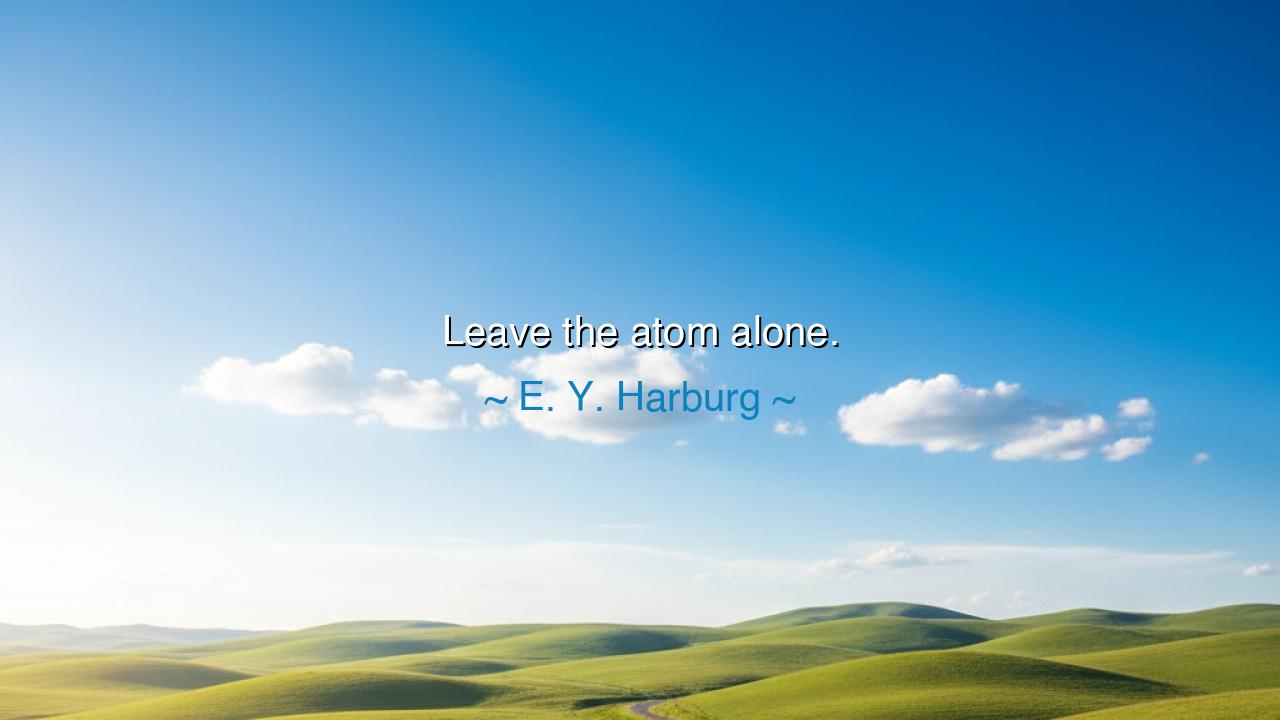
Leave the atom alone.






"Leave the atom alone." These words from E. Y. Harburg carry a message that resonates deeply with the ancient wisdom of balance and restraint. In an age when humanity's curiosity and technological prowess have led us to the very building blocks of life itself, Harburg’s words serve as a cautionary reminder: not all things should be tampered with, and not all knowledge should be pursued without consideration of its consequences. The atom, that fundamental particle of creation, represents not only the power to build but also the potential to destroy. It is both the source of life and the harbinger of chaos, and Harburg’s plea to "leave the atom alone" echoes a profound understanding of the danger in wielding forces we cannot fully understand or control.
In the ancient world, the wisdom of balance was held in high regard. The great Greek philosopher Heraclitus spoke of the unity of opposites, of how order and chaos are intertwined and must be in balance. Just as the universe thrives on the interplay of forces, so too does humanity need to understand when to act and when to withhold action. The pursuit of knowledge and power can be a noble endeavor, but when taken too far or pursued without caution, it leads to disruption and destruction. Harburg’s words can be seen as a modern reflection of this ancient wisdom—a call to pause and consider the implications of tampering with forces as fundamental and powerful as the atom.
Consider the story of Prometheus, the Titan who defied the gods to bring fire to humanity. In giving fire, he bestowed upon humankind the power to create and destroy. Fire, in its essence, is both a giver and a taker of life. It can warm and sustain, but it can also burn and consume. Prometheus’s gift, while revolutionary, led to suffering, as humanity struggled to understand the responsibility that came with such a powerful force. Like fire, the atom is a force that holds great potential—it can fuel our cities, cure diseases, or light the darkest corners of the earth. But it can also obliterate civilizations and create a world of ruin. Harburg’s plea to “leave the atom alone” is a recognition of the power of knowledge, and the need for humanity to approach such knowledge with a deep sense of responsibility.
In the modern era, we have seen the consequences of not heeding such wisdom. The advent of nuclear technology, with its promise of unlimited energy, also brought the threat of nuclear war and the creation of weapons of mass destruction. The atomic bomb, born from the discoveries of scientific minds, was intended to harness the power of the atom, but its first use in Hiroshima and Nagasaki showed the devastating force that lies within this particle of creation. The knowledge of the atom, while advancing human civilization, also opened the door to a new kind of destruction. Oppenheimer, one of the creators of the atomic bomb, famously quoted the Bhagavad Gita, saying, "Now I am become Death, the destroyer of worlds." This reflects the burden of wielding knowledge and power that, once unleashed, cannot be easily contained.
The lesson in Harburg’s quote is one of wisdom and restraint. While knowledge is a gift, it is also a responsibility—a responsibility that humanity has too often taken lightly. The pursuit of power, especially when it comes to forces as fundamental as the atom, should never be undertaken without a deep understanding of its moral and ethical implications. Just as ancient philosophers warned against the unchecked ambitions of kings and rulers, so too must we be wary of the dangers of unchecked scientific progress. The power to reshape the world should never come without a careful contemplation of its consequences, for once unleashed, the forces of nature and science can be as destructive as they are constructive.
In our own lives, let us reflect on the lesson of the atom. How often do we, in our own pursuits, push forward with ambition, with little thought of the larger impact our actions may have on others or the world around us? Whether in our careers, in our relationships, or in our approach to technology, we must always ask ourselves: Are we proceeding with caution? Are we seeking balance in our pursuit of progress? Just as we have learned to harness the power of the atom, let us also learn to wield the power of wisdom, acting in ways that promote life, not destruction, and harmony, not chaos.
Thus, Harburg’s plea to "leave the atom alone" is not just about the literal atom; it is a metaphor for all of the unchecked forces of progress in our world. Let us be mindful of our actions and recognize that true advancement comes not from dominance over nature or the pursuit of unlimited power, but from a balanced approach that honors the delicate interplay of creation and destruction. May we tread carefully, seek wisdom, and ensure that the power we unleash brings life, not ruin.






AAdministratorAdministrator
Welcome, honored guests. Please leave a comment, we will respond soon